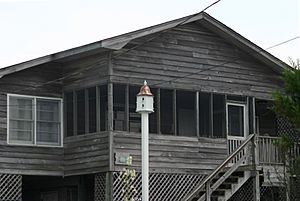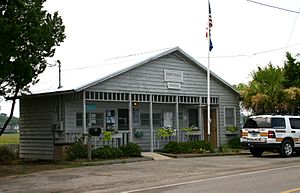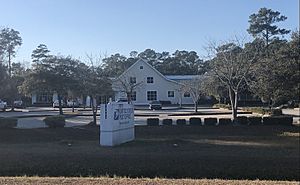Pawleys Island, South Carolina facts for kids
Quick facts for kids
Pawleys Island, South Carolina
|
|
|---|---|
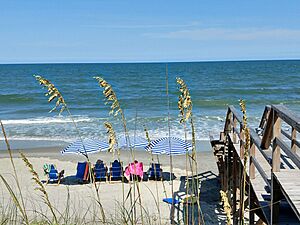
Beach at Pawleys Island, South Carolina
|
|
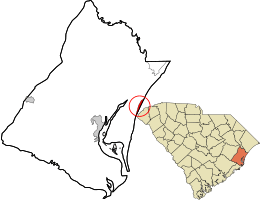
Red circle shows the location within Georgetown County and the state of South Carolina.
|
|
| Country | United States |
| State | South Carolina |
| County | Georgetown |
| Incorporated (town) | 1938 |
| Incorporated (city) | 1957 |
| Area | |
| • Total | 0.99 sq mi (2.57 km2) |
| • Land | 0.70 sq mi (1.82 km2) |
| • Water | 0.29 sq mi (0.75 km2) |
| Elevation | 3 ft (0.9 m) |
| Population
(2020)
|
|
| • Total | 130 |
| • Density | 185.45/sq mi (71.57/km2) |
| Time zone | UTC-5 (EST) |
| • Summer (DST) | UTC−4 (EDT) |
| ZIP Code |
29585
|
| Area code(s) | 843, 854 |
| FIPS code | 45-55015 |
| GNIS feature ID | 1231638 |
| Website | www.townofpawleysisland.com, |
Pawleys Island is a small town in Georgetown County, South Carolina, United States. It's also the name of the Atlantic coast barrier island where the town is located.
In 2020, about 130 people lived in Pawleys Island. The town is only on the island itself. However, the name "Pawleys Island" often refers to a larger area. This includes parts of the mainland next to the island. This mainland area has shops and homes.
The island is connected to the mainland by two bridges. It's part of The Grand Strand, a popular coastal area. Pawleys Island is one of the oldest vacation spots on the East Coast of the United States.
Contents
History of Pawleys Island
Early Inhabitants and European Arrival
The first people known to live around Pawleys Island were the Waccamaw and Winyah tribes. These Native American groups have a history going back over 10,000 years. The Waccamaw lived along the Waccamaw River. They were skilled farmers, growing many crops. They also raised animals like deer, chickens, and ducks.
The first Europeans arrived from Spain in 1521. Their arrival had a very difficult impact on the Waccamaw and Winyah people. Many were captured, became sick from new diseases, or lost their land and food sources. The Winyah tribe disappeared by 1720. However, the Waccamaw tribe and their culture still exist today. They are known as the Waccamaw Indian People of Conway, South Carolina. They work to improve the lives of South Carolina's original inhabitants.
Pawleys Island as a Resort Area
Pawleys Island became a beach resort in the early 1700s. George Pawley, who the island is named after, inherited the land. He sold parts of it to wealthy rice planters. These planters wanted a cool place by the ocean to escape mosquitoes that caused malaria in the summer.
In 1791, President George Washington visited the Grand Strand. He traveled to Pawleys Island to see the Alston family, who owned many plantations there.
Changes Over Time
In 1989, Hurricane Hugo hit the island. Some cottages were washed away, but new ones have been built since then. The island has rules against most commercial or industrial buildings. Only a few older inns and a condominium complex are allowed.
The town government officially formed in 1985. Pawleys Island is a great place for outdoor activities. The ocean water is warm from May to October. You can enjoy fishing, crabbing, shrimping, and birdwatching for most of the year.
Some important historic places on the island are All Saints Church, Cedar Grove Plantation Chapel, and the Pawleys Island Historic District. These places are listed on the National Register of Historic Places.
Geography of Pawleys Island
Pawleys Island is located near U.S. Route 17. It's about 10 miles (16 km) east of Georgetown. The island itself is a little over 3 miles (4.8 km) long. It is about 1/4 mile (0.4 km) wide. To the east is the Atlantic Ocean.
The island is a sandy barrier island. It has some sand dunes on its northern end that are about 15 feet (4.6 m) high. The southern end of the island is very low. Behind the island, there is a tidal creek and marsh area.
The United States Census Bureau says the town covers about 1.0 square mile (2.6 km²). Most of this is land, and about 0.3 square miles (0.78 km²) is water.
Population and People
| Historical population | |||
|---|---|---|---|
| Census | Pop. | %± | |
| 1990 | 176 | — | |
| 2000 | 138 | −21.6% | |
| 2010 | 103 | −25.4% | |
| 2020 | 130 | 26.2% | |
| U.S. Decennial Census | |||
In 2000, there were 138 people living in the town. By 2010, the population had gone down to 103. However, in 2020, it increased to 130 people.
Most households in Pawleys Island are made up of individuals or married couples. Many residents are 45 years old or older.
The Gray Man Ghost Story
Pawleys Island has a famous local ghost story about The Gray Man. People say this ghost has walked the coastline for almost 200 years. His presence is believed to warn people about hurricanes and other dangers.
The most common story about the Gray Man began in 1822. A young woman was staying on the island with her family. She heard that her fiancé was coming to join her. She was very excited and prepared all his favorite foods.
However, as her fiancé was traveling to the house, he decided to race his servants on their horses. He took a shortcut through a marsh. His horse stumbled, and he fell off. Despite his servants' efforts, he sank into the mud and died.
The news of his death made the young woman very sad. She had upsetting dreams and visions of him. Her family took her to Charleston to see a doctor. Just hours after they left, a hurricane hit the coast. Almost everyone on Pawleys Island died. But the family's house, where the young woman had been, was untouched. Many believe the Gray Man warned them to leave.
Education
Pawleys Island has a public library. It is a branch of the Georgetown County Library system.
Notable People
Here are some people who were born on Pawleys Island:
- Elizabeth Allston Pringle (1845–1921), a plantation owner and writer.
See also
 In Spanish: Pawleys Island para niños
In Spanish: Pawleys Island para niños


